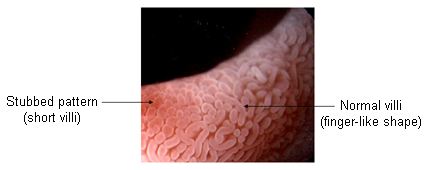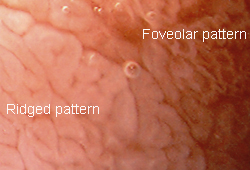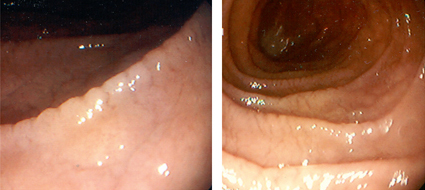Approach
TS should be suspected in any patient with chronic diarrhoea, weight loss, and signs/symptoms of malabsorption who has spent more than 2 weeks living in an endemic tropical area.
History
In non-native patients, the symptoms of malabsorption tend to shortly follow an acute diarrhoeal illness. Natives tend to have a more indolent onset of malabsorption and chronic diarrhoea. Generalised symptoms of malabsorption (weight loss, steatorrhoea, fatigue) and features suggestive of specific nutrient deficiencies should raise suspicion of TS.
Physical examination
If the patient displays any of the wide range of findings associated with specific nutritional deficiencies, suspicion of TS should be raised, especially if the combination of findings suggests malabsorption of 2 or more nutrients. Such findings might include glossitis, cheilitis, altered sensation, diminished deep tendon reflexes, pallor and rash in cases of B12 deficiency; leg swelling, hair loss, and pedal oedema in case of hypoproteinaemia; and dry eyes in case of vitamin A deficiency.
Key tests
FBC shows macrocytic anaemia; the diagnosis of TS should be questioned if increased MCV is not present.
Blood tests, including folate and vitamin B12 levels, quantitative faecal fat assay, and D-xylose test should be performed to confirm the clinical impression of malabsorption.[1]
Further radiographical, stool, and blood tests should be requested to rule out other possible causes of symptoms such as helminth infection, lymphoma, and coeliac disease.
If TS is still suspected, request an upper gastrointestinal endoscopy to obtain small-bowel biopsies. Duodenal and/or jejunal biopsies typically reveal short villi, elongated crypts, and inflammatory cells in the lamina propria; none of these findings are specific for TS. While these histological changes can be indistinguishable from those seen in patients with coeliac disease, TS is associated with a much more pronounced eosinophilic infiltrate in the duodenum than is seen in coeliac disease.[24][Figure caption and citation for the preceding image starts]: Endoscopy, normal and tropical sprue (TS) villi changes, duodenumFrom the collection of Dr M. Guelrud; used with permission [Citation ends]. [Figure caption and citation for the preceding image starts]: Tropical sprue; ridged and foveolar patterns, duodenumFrom the collection of Dr M. Guelrud; used with permission [Citation ends].
[Figure caption and citation for the preceding image starts]: Tropical sprue; ridged and foveolar patterns, duodenumFrom the collection of Dr M. Guelrud; used with permission [Citation ends]. [Figure caption and citation for the preceding image starts]: Tropical sprue; scalloping, mosaic appearance, and mucosal grooves; duodenumFrom the collection of Dr M. Guelrud; used with permission [Citation ends].
[Figure caption and citation for the preceding image starts]: Tropical sprue; scalloping, mosaic appearance, and mucosal grooves; duodenumFrom the collection of Dr M. Guelrud; used with permission [Citation ends].
Use of this content is subject to our disclaimer